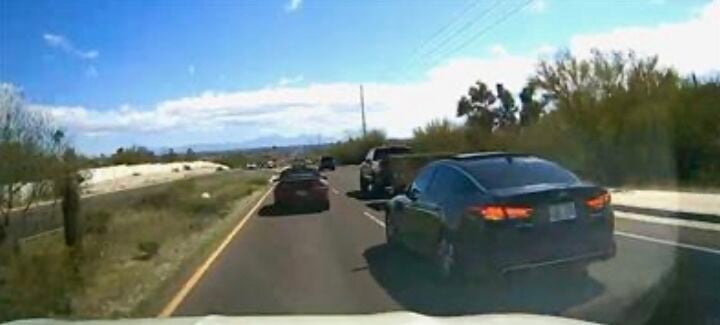After a record-breaking year in traffic fatalities, Tucson police are asking drivers to go online to identify dangerous drivers using dash-cam videos and images.
Traffic Watch is an online tool allowing people to report violations such as speeding, racing and reckless driving by filling out a survey rather than calling 911. The survey also includes an interactive map where users can pinpoint the exact location the violation happened. And it lets users upload video and photographs of potential violations.
After the user submits a violation, a motor officer will then review the report and determine what action, if any, to take. The response could range from a courtesy letter to a citation or arrest.
After working in TPD’s communications department, Sgt. Aaron Marquis, who oversees the Police Department’s motor squad, said he noticed people were calling 911 to report aggressive driving and realized a system wasn’t in place to deal with such calls.
That prompted the idea for Traffic Watch.
Like a neighborhood watch program, Marquis said they wanted to create a tool involving the public since “community eyes are everywhere.”
“Right now we’re under 20 motorcycle officers, so obviously, they can’t be throughout the entire city,” Lt. Lauren Pettey, who is a part of TPD’s traffic division, said. “This is a good way to get the community involved and report these type of driving infractions.”
Since launching at the end of March, the department has received up to 70 submissions. Marquis said he’s seen submissions from neighborhood associations reporting reckless driving and many complaints about speeding, tailgating and people cutting in and out of traffic.
Pettey said they have even gotten some good ideas from the public about improving the online tool. Thanks to community members, the survey now includes a section where people can report vehicles with excessive noise. A Spanish version of the tool is in the works too.
In addition to the survey, the online tool also allows individuals to upload photos and videos, such as footage from dashboard cameras, to help positively identify the driver in question. So far, Marquis said they have received quite a few photos and some videos from home security and business surveillance cameras.
Those who report violations without photo or video will have to describe the driver in the question. In those situations, Pettey said TPD will not be able to issue a citation, but will send a letter instead.
The survey warns people making a report that includes footage they recorded while driving — rather than from a dash-mounted camera — that they too could get cited because it is illegal here to use mobile devices while driving.
In a Facebook post announcing the new program, some people raised concerns about dashboard cameras and their similarities to red light cameras, which have been outlawed in the city.
Dashboard cameras are just like the security cams at businesses or Ring doorbell cameras used at many homes, said David Fritsch, a public information officer for the department. Public submissions of photographic evidence have always been accepted, Fritsch said.
“It’s a community, it’s not the government watching you,” Fritsch said. “It’s hey, I’m watching my neighbor, because I care about my neighbor’s safety, I don’t want them to get hit by a car on the way to the store. So that’s where it’s different for me in my eyes.”
Most importantly, Marquis wants to ensure the community that they are thoroughly vetting and filtering the submissions. When reporting a violation, the individual must include their name and contact information so officers can follow up and get more details.
“It’s not just going to be an automated process where someone will get a citation or someone will get a letter through the mail,” Marquis said. “The goal is that we were attempting to reduce serious collisions and fatalities on the roadway. We want to make the streets and our roadways safe for everybody.”
So far this year, Tucson police have investigated 26 fatal crashes. 10 of those crashes have been pedestrian fatalities.
Recently, Marquis said they thought they had a good submission from someone who included photo proof. However, through the vetting process, it was discovered the individual had “ulterior motives.”
To deter issues like this, the survey warns the community that there are penalties for those filing fake reports and harassment.
Ultimately, Pettey says he wants the tool to be educational for Tucson drivers. The courtesy letters will serve as a friendly reminder, letting the driver who gets one know that what they did was a traffic violation.
“A lot of times it’s just going to be educational, which I think is great,” Pettey said. “You get a warning that can change your driving behavior. It’s not all about enforcement. It’s about education.”
For more information on the program or if you need to make a report, visit www.tucsonaz.gov/police/traffic-related-information.
Get your morning recap of today's local news and read the full stories here: http://tucne.ws/morning





